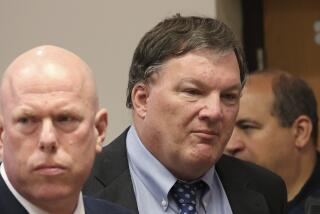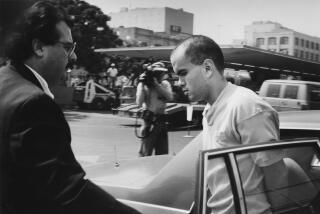Book Names New Suspect in 1954 Sheppard Killing
That notorious July night remains just a blur to Sam Reese Sheppard.
Only 7 at the time, Sheppard remembers being awakened from a deep slumber and rushed from his suburban Cleveland home in a panic by neighbors--vaguely aware, he says, that âsomething was terribly wrong.â
Sheppard and many other sleuths both amateur and professional have spent nearly the last half-century trying to figure out exactly what happened that night when his pregnant mother, Marilyn Sheppard, was bludgeoned to death.
From one of two new dueling whodunits comes the latest chapter--and one of the more novel twists--in a mystery that America seems unable to put down.
In a provocative book due out next month, former FBI agent Bernard F. Conners uses forensic evidence, an odd bite mark, eyewitness testimony and other clues to point the finger at a new suspect in the case.
Connersâ book, âTailspin,â joins the ranks of thousands of articles, books, documentaries and movies aiming to solve the 1954 murder. Even the courts in Ohio have revisited the issue, turning down an appeal a few months ago from the Sheppard family in their effort to exonerate the victimâs husband, Dr. Sam Sheppard, who served 10 years in prison for the murder.
Conners argues that the real killer was not Sam Sheppard nor the coupleâs much-maligned window washer but rather a handsome, âbushy-hairedâ Air Force major named Jim Call who went AWOL and became a gambler, a burglar, a convicted cop-killer and a fugitive.
Call died in a car accident in 1974, six years after he was released from Attica prison in New York, but Conners believes that solving the mystery even now is crucial. âWe have a very compelling case. I feel very strongly that Sam Sheppard should be vindicated,â Conners said. âIt was outrageous what happened to him.â
Connersâ book is already stirring controversy. Some people familiar with the case are attacking his evidence as thin, while others, including several prominent law enforcement officials, praise Conners as a real-life Hercule Poirot.
Sam Reese Sheppard, now 54 and a dental hygienist in Oakland, is among the believers.
âI think we now have a serious suspect who was basically ignored at the time,â the victimâs son said in an interview.
So begins a fresh round of scrutiny into a case that Sheppard expert James Neff said âhas all the elements.â
âIt was a case that just shook us up. It was all so powerful. It was the original media frenzy,â said Neff, who published his own book, âThe Wrong Man,â in November, concluding that Richard Eberling, the Sheppardsâ window washer, was probably the culprit.
With a headline-hungry Cleveland newspaper publisher pushing the case, Marilyn Sheppardâs murder on July 4, 1954, became a national sensation with decades-long staying power.
There was the shock of a pregnant young wife murdered in her own bedroom in an elite suburban enclave. There was the arrest of her handsome husband, a doctor in a prominent medical family that ran a local hospital. There were his proclamations of innocence--and his insistence that he had battled a âbushy-haired manâ who fled the scene.
There was the defense attorney, F. Lee Bailey, catapulted to fame by the case. And there was âThe Fugitiveâ--and the legend, often discounted, that the popular television series and the Harrison Ford film about a wrongly accused doctor searching for his wifeâs one-armed killer were inspired by the Sheppard case.
Long before Charles Manson, O.J. Simpson or Robert Blake, the allegations against Sam Sheppard led to one of the first great âtrials of the centuryâ in America. âEveryone was asking, âDid he or didnât he? Heâs a doctor, heâs so handsome, how could he?â â Neff said.
Sam Sheppard was convicted of murder, but the U.S. Supreme Court ordered a new trial in 1966 because of the âcarnivalâ atmosphere at the first one. At his retrial, Sheppard was found not guilty. But the damage was already done.
The suicides of three Sheppard family members were linked to the trauma surrounding the killing and conviction, and Sheppard descended into depression, eventually becoming a pro wrestler by the name of âKillerâ Sheppard. He died in 1970.
Prison âdestroyed him,â his brother, Stephen Sheppard, a retired doctor in Oregon, said in an interview. âHe came out and turned into a user of uppers and downers and alcohol and anything else. You go to prison for 10 years, you come out a convict.â
One of the many amateur detectives on the case was Air Force officer George Warburton. He was convinced that a burglar, Jim Call, who was briefly questioned in New York about the murder, was involved. Warburton took his theory to Neff, who was then researching âThe Wrong Man,â but Neff wasnât persuaded.
Warburton also sent Conners a batch of material, however, and the former FBI agent was intrigued.
Conners, a Renaissance man of sorts who built a successful career in Albany, N.Y., as a businessman, best-selling author, publisher and movie producer after leaving the FBI, had never been much interested in the Sheppard case. He never even watched âThe Fugitive.â
But he thought Warburton might be on to something, and he and his staff spent much of the last five years dusting off long-lost files, interviewing witnesses and pursuing leads.
âTailspin: The Strange Case of Major Call,â a 506-page tome that includes dozens of photo exhibits and detailed addenda, traces the dramatic bends in Callâs life, from his rise as a brash and decorated Air Force aviator to his swift fall into depression and crime after the 1952 death of his wife from a viral infection.
Conners maintains that, in the midst of a string of residential burglaries nationwide, Call was visiting his sister in Ohio in the summer of 1954 and broke into the Sheppardsâ home.
With Sam Sheppard asleep downstairs, a startled Marilyn Sheppard awoke to find the burglar in her room, triggering a struggle that ended when Call struck her on the head repeatedly with his Luger handgun and his burglarâs pry bar, Conners maintains.
Among the key evidence Conners cites are a bite mark on Callâs hand that he believes was made when Sheppard bit her victim, dislodging several of her teeth; a small scrap of brown leather near the victimâs bed, consistent with Callâs Air Force-issue flying gloves; and the testimony of nine eyewitnesses near the Sheppard home who described a âbushy-haired figureâ fitting Callâs description.
Neff, who was raised in Cleveland and can tick off the caseâs most minute details, concurs on one issue: Sam Sheppard didnât do it. Other than that, he doesnât buy Connersâ arguments.
âItâs an interesting theory, but itâs farfetched,â Neff said. âThe physical evidence contradicts the Call theory. . . . Marilyn Sheppard was killed by someone that knew the house and knew her.â
So the debate, and the armchair sleuthing, continue.
âThe beat goes on,â Stephen Sheppard said. âThereâs no end to this, and there will never be an end to this until this case is solved.â
More to Read
Sign up for our Book Club newsletter
Get the latest news, events and more from the Los Angeles Times Book Club, and help us get L.A. reading and talking.
You may occasionally receive promotional content from the Los Angeles Times.







